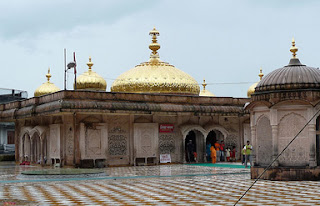Above is an
old photo from around 1920 which shown the Amritsar Bazar area near the
Golden Temple. from the times of Babaji Maharaj. Shri Babaji
Maharaj and Shri Nathji used to stay and frequent the Amritsar Bazaar
area in the walled city. Bellow are the names and photos of four areas
in Amritsar were Babaji Maharaj used to stay –
----------------------------------------------------------------------------------------------------------------
He
first stayed with Lala Gokul Chand Kapoor, a Cloth Merchant, in the
bazaar. The Bazaar is located in the walled city close to the golden
temple. A satellite photo and an actual photograph of the Bazar is
given.
-----------------------------------------------------------------------------------------------------------------
Later he stayed at a house at Ramtalaayi.
Ram Talayi is a Temple complex which includes a temple of Lord Ram and a holy
pond. There residential area around the temple complex is also called Ramtaayi.
Photos of the Temple complex and the Holy pond are given along with the satellite
photo were we can see the pond.
-------------------------------------------------------------------------------------------------------------
Then
Babiji Maharaj shifted to Namak
Mandi. This place has changes, from how it looked from the days of Babji
Maharaj. It is no longer a trading market for Salt as it used to be. I
have given the photograph of Namak Mandi Chock and also a satellite
photo of the area.
----------------------------------------------------------------------------------------------------------------
Later Babji Maharaj. went on to live
with Lala Kaahan Chand Saheb Maheshwari who lived near the Jaure Peepal area. Lala
Kaahan Chand was in great worldly difficulties at the time, and it was only the
sustaining spiritual power of Shri Babaji Bhagwan that kept him at peace while
these difficulties lasted, and then took him out of this difficult phase of
life with ease. The flame of faith was kindled in the heart of Kaahan Chand.
While the troubles had lasted, it was as if he had been walking in the hot sun,
but Shri Babaji Bhagwan had placed a protecting umbrella over his head. Jaure
Peepal area is named after an old Peepal tree which still stands today. Very
few old timers of Amritsar only knew of this place. It is located near the famous
Hindu Sabha College. The Hindu Sabha College, Amritsar
was founded in 1924 and this old building is still preserved in its original condition.
The Jaure Peepal is located in the maze of small lanes in this old part of the
city near the college. My relative Dr. Sandeep Sharma did the research on the
place and provided the photo of that exact Peepal tree, near the house of Lala Kaahan Chand.
The photograph of the College and the satellite photo of the area is also given
were we can also see the Golden temple.
























